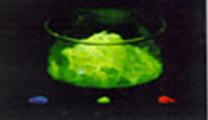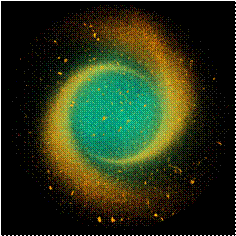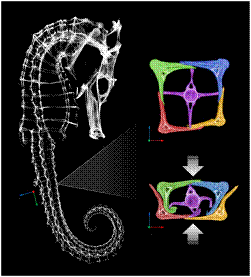|
Mckittrick group |
Department of Mechanical and Aerospace EngineeringMaterials Science and Engineering Program |


|
Research Focus |
|
The McKittrick group has major interests in two broad areas:
Rare-earth doped Nitride Alloy Synthesis
Biological materials Bioinspiration in Engineering Video Seahorses Video
Bone demineralization and deproteination Bone can be demineralized (removing all of the mineral phase hydroxyapatite) or deproteinated (removing all the biopolymer phase, collagen). The synergistic effect of the mineral/biopolymer can be determined through studies of each component.
Structure and mechanical behavior of natural biological materials Structural biomaterials such as mollusk shells, bones, teeth, tusks, arthropod exoskeletons, antlers, horns and turtle shells have remarkable strength and toughness given their low densities.
|
|
Professor Joanna McKittrick
Maintained by: Ekaterina Evdokimenko
|
|
To contact us: |

|
Luminescent materials fluoresce under activation of an external energy source such as an electron beam, photons or an electric field. These materials have applications in display devices (flat panel displays and CRTs), in solid state lighting (white-emitting LEDs) and as remote temperature sensors (thermographic phosphors). Our research on luminescent materials is currently in two directions: |
Luminescent phosphors from combustion synthesis; under 360nm excitation. The red emitter is Y2O3 activated with Eu3+, 4 at.%. The green emitter is Y3Al5O12, commonly known as YAG, activated with Tb3+. The blue powder is Y2SiO5 activated with 0.0075 at.% Ce3+.

|
Biomimetic Materials by Freeze Casting The microstructure in this image was created by freeze casting TiO2 powders, using ice as a template to control the architectural morphology of the scaffold. The porous microchannels are ~10µm wide. The microstructures and mechanical behavior of freeze-cast scaffolds mimic that of natural bone and nacre. Further reading: Porter M.M., McKittrick J., Meyers M.A. (2013). "Biomimetic Materials by Freeze Casting." JOM. (in press) http://dx.doi.org/10.1007/s11837-013-0606-3 |

|
Spiraling Ceramics Inspired by the spiraling nature of the narwhal tusk, the spiral pattern in this image was created by the alignment of magnetic nanoparticles to a rotating magnetic field in a cylindrical freeze-cast scaffold composed of TiO2 and Fe3O4. The cylindrical scaffold is ~20mm in diameter. Further reading: Porter M.M., Yeh M., Strawson J., Goehring T., Lujan S., Siripasopsotorn P., Meyers M.A., McKittrick J. (2012). "Magnetic freeze casting inspired by nature." Materials Science and Engineering: A. 556: 741-750. PDF file |
|
Bioinspired materials |

|
Functional Seahorse Armor Seahorses get their exceptional flexibility from the structure of their bony plates, which function as a flexible subdermal armor. The seahorse skeleton is composed of several bony plates arranged in overlapping, articulating rings along the length of the fish. The bony plated armor of seahorses may serve as inspiration for future biomimetic technologies such as flexible, prehensile robotics. Further reading: Porter M.M., Novitskaya E.E., Castro-Ceseña A.B., Meyers M.A., McKittrick J. (2013). "Highly deformable bones: unusual deformation mechanisms of seahorse armor." Acta Biomaterialia. (in press) PDF file
|
|
Synthetic composites/laminates based on the natural materials but using engineering materials can result in materials that have superior mechanical properties compared to other composites. |